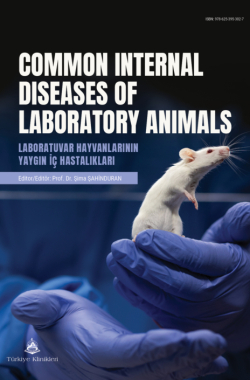Diabetes Mellitus in Laboratory Animals
Mehmet Çağrı KARAKURUMa , Işınsu AYTOPa
aBurdur Mehmet Akif Ersoy University Faculty of Veterinary Medicine, Department of Internal Medicine, Burdur, Türkiye
Karakurum MÇ, Aytop I. Diabetes mellitus in laboratory animals. In: Şahinduran Ş, ed. Common Internal Diseases of Laboratory Animals. 1st ed. Ankara: Türkiye Klinikleri; 2024. p.59-62.
ABSTRACT
Diabetes mellitus is a major health problem with a high prevalence worldwide. Animal models have contributed greatly to the study of diabetes mellitus, an endocrine disease characterized by abnormal glucose homeostasis due to deficiencies in insulin secretion or action. It offers researchers the opportunity to control in vivo the genetic and environmental factors that may influence the development of the disease and the occurrence of its complications. Continuing such studies in spontaneously diabetic animals will help to better understand the etiology, pathogenesis and treatment. This chapter focuses on spontaneous diabetes and treatment options reported in laboratory animals such as ferrets, hamsters, chinchillas, guinea pigs and rabbits.
Keywords: Diabetes; laboratory animals; insulin; spontaneous
Kaynak Göster
Referanslar
- Lang CM, Munger BL. Diabetes mellitus in the guinea pig. Diabetes. 1976;25(5):434-43. [Crossref] [PubMed]
- Conaway HH, Faas FH, Smith SD, Sanders LL. Spontaneous diabetes mellitus in the New Zealand white rabbit: physiologic characteristics. Metabolism. 1981;30(1):50-6. [Crossref] [PubMed]
- Huerkamp MJ. Guinea Pigs. In: Laber-Laird K, Swindle MM, Flecknell P, eds. Handbook of Rodent and Rabbit Medicine. 2nd ed. Great Britain: Elseiver Science; 1996. p. 130-1.
- Quesenberry KE, Carpenter JW. Endocrine diseases. In: Quesenberry KE, Rosenthal KL, eds. Ferrets, Rabbits, and Rodents Clinical Medicine and Surgery. 2nd ed. United States of America, St. Louis, Missouri: 1997. p. 88-9.
- Donnelly TM. Disease Problems of Chinchillas. In: Quesenberry KE, Carpenter JW. Ferrets, Rabbits, and Rodents Clinical Medicine and Surgery. 2nd ed. United States of America, St. Louis, Missouri; 1997. p. 263.
- Jenkins JR. Diseases of geriatric Guinea pigs and chinchillas. Vet Clin North Am Exot Anim Pract. 2010;13(1):85-93. [Crossref] [PubMed]
- Vannevel J. Diabetes mellitus in a 3-year-old, intact, female guinea pig. Can Vet J. 1998;39(8):503.
- Ewringmann A, Göbel T. Diabetes mellitus in rabbits, guinea pigs and chinchillas. Kleintierpraxis. 1998;43:337-48
- Norton JN, Reynolds RP. Diseases and Veterinary Care. In: Suckow MA, Stevens KA, Wilson RP, eds. The Laboratory Rabbit, Guinea Pig, Hamster, and Other Rodents. 1st ed. United States of American: Elseiver; 2012. p.1001. [Crossref]
- Belis JA, Curley RM, Lang CM. Bladder dysfunction in the spontaneously diabetic male Abyssinian-Hartley guinea pig. Pharmacology. 1996;53(1):66-70. [Crossref] [PubMed]
- O'Rourke D. Disease problems of guinea pigs. Ferrets, Rabbits, and Rodents Clinical Medicine and Surgery. In: Quesenberry KE, Carpenter JW, eds. 2nd ed. United States of America, St. Louis, Missouri; 1997. p. 252.
- Colby LA, Nowland MH, Kennedy LC. Clinical Laboratory Animal Medicine an Introduction. 5th ed. Hoboken, NJ: Wiley-Blackwell; 2020. p.237.
- Vannevel J. Diabetes in the guinea pig--not uncommon. Can Vet J. 1999; 40(9):613.
- Lipman NS, Foltz C. Hamsters. Handbook of Rodent and Rabbit Medicine. In: Laird-Laber K, Swindle MM, Flecknell P, eds. 2nd ed. Great Britain: Elseiver Science; 1996. p. 80.
- Stein S, Walshaw S. Rabbits. In: Laird-Laber K, Swindle MM, Flecknell P, eds. Handbook of Rodent and Rabbit Medicine. 2nd ed. Great Britain: Elseiver Science; 1996. p. 207.

